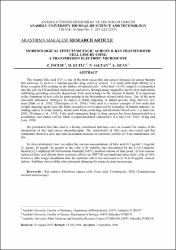| dc.contributor.author | İncesu, Z. | |
| dc.contributor.author | Kutlu, M. | |
| dc.contributor.author | Saltan, N. | |
| dc.contributor.author | İşcan, A. | |
| dc.date.accessioned | 2015-03-17T09:07:42Z | |
| dc.date.available | 2015-03-17T09:07:42Z | |
| dc.date.issued | 2009 | |
| dc.identifier.issn | 13023160 | |
| dc.identifier.uri | https://hdl.handle.net/11421/1705 | |
| dc.description.abstract | The vitamin folic acid (FA) is one of the most successful anti-cancer strategies in cancer therapy that molecule is used as a tumour-specific drug delivery system. FA binds with high affinity to a folate receptor (FR) existing on the surface of tumoral cells. After that, FA-FR complex is transported into the cell via FR-mediated endocytosis and moves through many organelles involved in endocytotic trafficking providing cytosolic deposition. Folic acid belongs to the vitamin B family. It is important in the formation of new cells by participating in the biosynthesis of nucleotide bases. One of the most succesful anticancer strategies in cancer is folate targeting to tumor-specific drug delivery sys-tems.(Dube et al., 2002; Christopher et al., 2001). Folic acid is a typical example of low molecular weight targeting agent since the folate receptor is over-expressed by a number of human tumours, including cancer of ovary, kidney, uterus,testis brain,colon lung and myeloetic blood cells. (Lu and Low, 2002; Weitman et al., 1992). Folic acid conjugated drugs or drug carriers has been demonstrated to a accumulate into tumor cell by folate receptor-mediated endocytosis (Lu and Low, 2002; Wang and Low, 1998). We postulated that folic acid is a dietary constituent that may serve as a model for studies of the interactions of diet and cancer chemotheraphy. The cytotoxicity of folic acids was tested and this compound showed a dose and time-dependent increase in cytotoxic activity in H-ras transformed cell line. In vitro cytotoxicity tests, we added the various concentrations of folic acid (0.3 μg/ml, 0.6 μg/ml, 10 μg/ml, 20 μg/ml, 40 μg/ml) to the cells. Cell viability was determined by the [3-(4,5-dimetyl-thiazoyl)-2,5-diphenyl-SH-tetrazolium bromide] (MTT) method various of time point. At low concentration of folic acid did not show cytotoxic effects on 5RP7 (H-ras transform hücre hattı) cells at 24 h. However, after longer incubation time the cytotoxic effect was increased to 21 % at 40 μg/mL concentration. And then observed the ultra structural changing by using electron microscope. | en_US |
| dc.description.abstract | Bir vitamin olan folik asit (FA), kanser tedavisinde tümöre özgü spesifik bir ilaç dağıtım molekülü gibi kullanılan en iyi antikanser stratejilerinden biridir. Folik asit tümörlü hücrelerin yüzeyinde çokça bulunan folat reseptörüne (FR) bağlanır. Daha sonra bu kompleks, hücre içerisine folat reseptörlerinin endositozu yoluyla alınır. B vitamini ailesinin bir üyesi olan folik asit, nükleotid bazlarının biyosentezine katılarak yeni hücrelerinin oluşumu açısından önem taşır. Kanserde en başarılı antikanser stratejilerinden birisi, folat ile hedeflenen spesifik tümörlü hücrelere ilaç dağıtımının sağlanmasıdır. Düşük molekül ağırlığına sahip olup, yüzeyinde folat reseptörü bulunduran, böbrek, uterus, testis, beyin, akciğer gibi pek çok insana ait ve kanserli olan organlarda bu sayede hedefleme yapabilmektedir (Lu and Low, 2002; Wang and Low, 1998). Folik asit ile konjuge edilmiş ilaç ya da ilaç taşıyıcılarının, folat reseptörlerinin endositozu yoluyla kanser hücreleri içerisine aliminin arttığı ispatlanmıştır. Folik asidin bir diyetsel unsur olduğu ve kanser kemoterapisi ile diyet arasındaki etkileşim ile ilgili çalışmalarda bir model olarak kullanılabileceği düşünülmüştür. Dolayısıyla folik asidin sitotok-sititesi test edilip, 5RP7 (H-ras transform hücre hattı) üzerindeki sitotoksik aktivitesinin zamana ve doza bağlı olarak arttığı belirlenmiştir. İn vitro sitotoksik testlerde folik asidin farklı konsantrasyonları (0.3 μg/ml, 0.6 μg/ml, 10 μg/ml, 20 μg/ml, 40 μg/ml) kanserli hücrelere eklenmiştir. Hücrelerin canlılığını çeşitli zaman periyotlarında uygulanan [(3-(4,5-dimetyl-thiazoyl)-2,5-diphenyl-SH-tetrazolium bromide] (MTT) metoduyla belirlenmiştir. Folik asidin düşük konsantrasyonlarda ve 24 saat sonunda, 5RP7 hücre hattında sitotoksik etkisi gözlenmezken, daha uzun inkübasyon periyotları sonunda (40 μg/ml konsantrasyonunda) sitotoksik etki % 21 oranında artmıştır. Yapısal değişiklikler ise Geçirimli Elektron Mikroskop(TEM) kullanılarak belirlenmiştir. | en_US |
| dc.language.iso | eng | en_US |
| dc.publisher | Anadolu Üniversitesi | en_US |
| dc.rights | info:eu-repo/semantics/openAccess | en_US |
| dc.subject | Rat Embryo Fibroblast Cancer Cells | en_US |
| dc.subject | Folic Acid | en_US |
| dc.subject | Cytotoxicity | en_US |
| dc.subject | Tem (Transmission Electron Microscope) | en_US |
| dc.subject | Sıçan Embriyo Fibroblast Kanser Hücreleri | en_US |
| dc.subject | Folik Asit | en_US |
| dc.subject | Sitotoksisite | en_US |
| dc.subject | Geçirimli Elektron Mikroskop (Tem) | en_US |
| dc.title | Morphological Effects of Folic Acid on H-Ras Transformed Cell Line by Using a Transmission Electron Microscope | en_US |
| dc.title.alternative | Folik Asidin H-Ras Transform Hücre Hattı Üzerindeki Morfolojik Etkisinin Geçirimli Elektron Mikroskop Kullanarak Belirlenmesi | en_US |
| dc.type | article | en_US |
| dc.relation.journal | Anadolu Üniversitesi Bilim ve Teknoloji Dergisi A - Uygulamalı Bilimler ve Mühendislik | en_US |
| dc.relation.publicationcategory | Makale - Ulusal Hakemli Dergi - Kategorisiz | en_US |


















